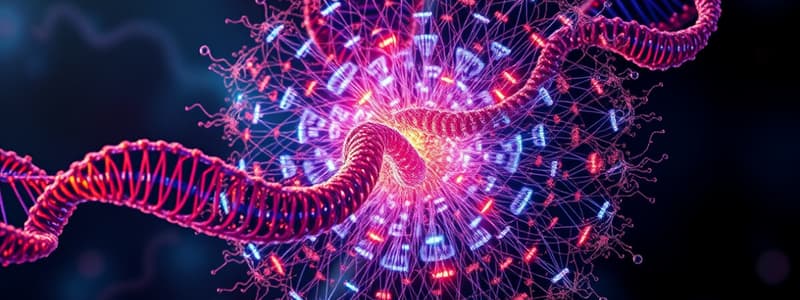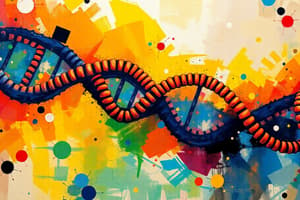Podcast
Questions and Answers
Which statement is true regarding the smooth endoplasmic reticulum?
Which statement is true regarding the smooth endoplasmic reticulum?
- It is primarily involved in the degradation of proteins.
- It functions mainly in lipid synthesis. (correct)
- It synthesizes glycoproteins.
- It contains ribosomes for protein synthesis.
What is the primary consequence of the absence of hexosaminidase A in Tay-Sachs disease?
What is the primary consequence of the absence of hexosaminidase A in Tay-Sachs disease?
- Increased levels of beta-glucuronidase.
- Accumulation of gangliosides. (correct)
- Decreased production of glycosaminoglycans.
- Improved lysosomal function.
Which of the following best describes peroxisomes?
Which of the following best describes peroxisomes?
- They lack a membrane structure.
- They primarily synthesize carbohydrates.
- They are involved in protein biosynthesis.
- They are called microbodies. (correct)
In mucopolysaccharidosis, what is typically absent?
In mucopolysaccharidosis, what is typically absent?
Which type of protein is embedded within the cell membrane?
Which type of protein is embedded within the cell membrane?
What is the primary role of adaptor proteins in phagocytosis?
What is the primary role of adaptor proteins in phagocytosis?
What is the primary function of membrane proteins as adhesion molecules?
What is the primary function of membrane proteins as adhesion molecules?
What is the function of clarithin during the process of phagocytosis?
What is the function of clarithin during the process of phagocytosis?
What role does dynamin play in phagocytosis?
What role does dynamin play in phagocytosis?
Lysosomal storage diseases result from a deficit in which of the following?
Lysosomal storage diseases result from a deficit in which of the following?
What does the crystalline core of peroxisomes primarily contain?
What does the crystalline core of peroxisomes primarily contain?
What compartment plays a critical role in determining the fate of internalized molecules during phagocytosis?
What compartment plays a critical role in determining the fate of internalized molecules during phagocytosis?
Which of the following statements regarding lysosomes is correct?
Which of the following statements regarding lysosomes is correct?
What is the primary characteristic of heterochromatin?
What is the primary characteristic of heterochromatin?
Which component is essential for the structure of nucleosomes?
Which component is essential for the structure of nucleosomes?
What is the primary function of the Golgi apparatus?
What is the primary function of the Golgi apparatus?
Which statement accurately describes the rough endoplasmic reticulum?
Which statement accurately describes the rough endoplasmic reticulum?
How do lysosomal enzymes function optimally?
How do lysosomal enzymes function optimally?
Which two subunits make up ribosomes in eukaryotes?
Which two subunits make up ribosomes in eukaryotes?
Which of the following is NOT typically associated with lysosomal function?
Which of the following is NOT typically associated with lysosomal function?
What distinguishes lysosomal storage diseases?
What distinguishes lysosomal storage diseases?
Flashcards are hidden until you start studying
Study Notes
Smooth Endoplasmic Reticulum
- Lacks ribosomes, distinguishing it from rough ER, and primarily involved in lipid synthesis.
- Higher pH of cytosol can inactivate certain contents, a safety measure for cell function.
Lysosomal Storage Diseases
-
Tay-Sachs Disease
- Caused by the absence of hexosaminidase A.
- Results in the accumulation of gangliosides, affecting neurological function.
-
Mucopolysaccharidosis
- Caused by absence of beta-glucuronidase.
- Leads to the accumulation of glycosaminoglycans, impacting cellular processes.
Membrane Proteins
-
Composed of proteins (55%) with types including:
-
Integral Proteins
- Embedded in or traverse the membrane, forming structural channels or pores.
-
Peripheral Proteins
- Located on either side of the membrane; function as enzymes or assist in transport processes.
-
-
Functions of Membrane Proteins
- Acts as adhesion molecules for cell communication.
- Integral proteins serve as receptors with a high affinity for specific ligands, initiating cell signaling.
- Ligands aggregate and cause invagination, leading to the formation of endosomes and vesicles.
Lysosomes
- Known as the cell's digestive system, containing hydrolytic enzymes collectively called acid hydrolases.
- Operate efficiently within an acidic environment, crucial for breaking down biomolecules.
- Plasma membrane is a phospholipid bilayer derived from the Golgi apparatus.
Phagocytosis
- Refers to the process of "cell eating."
- Involves pseudopodia formation, enclosing molecules in vacuoles, and fusing membranes to form phagosomes.
- Endosomes direct the fate of internalized molecules for recycling or degradation.
Clathrin-Mediated Endocytosis
- Adaptor proteins recruit clathrin, helping select cargo for endocytosis.
- Clathrin forms coated pits on the membrane, which bud off to create vesicles.
- Dynamin facilitates the final detachment of vesicles from the plasma membrane.
Chromatin and Nucleus
-
Heterochromatin
- Densely packed and typically inactive in gene expression.
-
Chromosomes
- Highly organized chromatin structure, condensed during cell division.
-
Nucleosomes
- The fundamental unit of chromatin, containing segments of DNA.
Genome and Genes
- Genome encompasses all genetic material, including coding and non-coding regions.
- Genes are specific DNA sequences that summon the production of proteins.
Endoplasmic Reticulum
- Acts as the cell's factory with two distinct regions:
-
Rough Endoplasmic Reticulum (RER)
- Characterized by ribosomes, focuses on protein synthesis.
- Ribosomes consist of ribosomal RNA (rRNA) and proteins, specifically the 60s and 40s subunits.
-
Lipid Synthesis
- Smooth ER involved in the biosynthesis of lipids and metabolic processes.
-
Acidic Environment of Lysosomes
- Optimal pH for acid hydrolases is around 5, while the cytosol's pH hovers around 7.4, emphasizing the importance of compartmentalization in cellular functions.
Studying That Suits You
Use AI to generate personalized quizzes and flashcards to suit your learning preferences.



